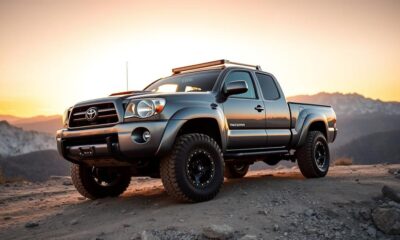Ford Tuning
Ranger Tuned Ford Ranger 2000 Tuning: Customizing Your Truck for Ultimate Performance
Join the journey of transforming your 2000 Ford Ranger into a performance powerhouse, and discover the secrets that await you.
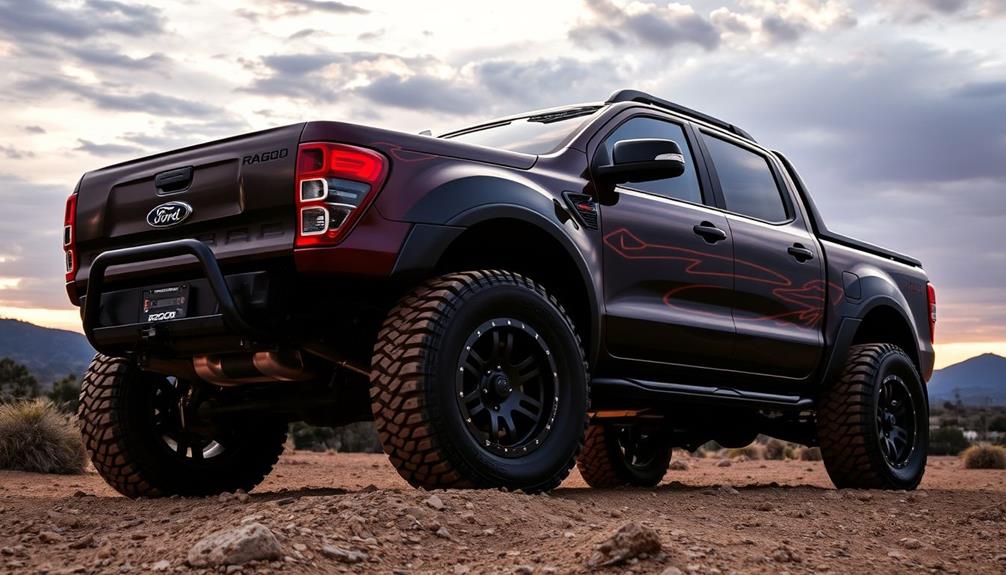
Customizing your 2000 Ford Ranger through tuning can reveal its true potential. With custom reflashes from skilled tuners, you can shave off 0.7 seconds in your 40-70 mph acceleration and gain 10-15 wheel horsepower. Using premium 93 octane fuel enhances responsiveness and allows for aggressive spark timing adjustments. The tuning process involves modifying fuel tables and ignition timing for peak performance. Investing in quality tuning can also improve fuel economy by up to 1 mpg in city driving. If you're keen to learn how to maximize your Ranger's capabilities, there's more insight ahead.
Key Takeaways
- Custom tuning via reputable tuners offers superior performance gains compared to generic chips, enhancing drivability and responsiveness.
- Upgrading to premium 93 octane fuel allows for aggressive spark timing adjustments, maximizing power output and efficiency.
- Performance tuning can improve 40-70 mph acceleration by up to 0.7 seconds, significantly enhancing your truck's responsiveness.
- Monitoring devices help track engine health and performance metrics, ensuring optimal tuning and identifying potential issues.
- Compliance with emissions standards is crucial; choose tuning options that enhance performance without compromising legal requirements.
Overview of Tuning Options
When it comes to tuning your 2000 Ford Ranger 4.0 OHV, you'll find that options are somewhat limited, but that doesn't mean you can't achieve noticeable improvements. The primary tuning options focus on enhancing performance through adjustments to factory computer settings.
You might consider custom reflashes from reputable tuners, as these generally yield better results than generic chip options. Investing in a quality tune typically ranges from $200 to $800+, depending on the complexity and expertise of the tuner.
Many users have reported a significant 0.7-second reduction in 40-70 mph acceleration with both 87 and 91 octane tunes, showcasing the effectiveness of custom tuning. Additionally, upgrading to premium fuel (93 octane) can allow for more aggressive spark timing adjustments during the tuning process, providing an extra boost in power.
While community feedback suggests tuning the 4.0 OHV may yield less improvement compared to SOHC engines, you can still achieve meaningful gains with the right tuning techniques and modifications.
Expected Performance Gains

Tuning your 2000 Ford Ranger 4.0 OHV can lead to impressive performance gains that enhance both acceleration and drivability. With a well-executed performance tune, you could see acceleration improvements of up to 0.7 seconds in the 40-70 mph range, especially when using premium 91 octane fuel. This upgrade not only boosts speed but also optimizes engine responsiveness, eliminating any hesitation after quick shifts for a smoother driving experience.
Moreover, performance tuning can improve your fuel economy by 0.5 to 1 mpg in city driving, which is a notable benefit for those looking to enhance efficiency without sacrificing power. You might even experience an increase of 10-15 wheel horsepower (whp) with the right enhancements, like upgraded downpipes and cold air intakes, paired with a performance tune.
Choosing a custom reflash from an experienced tuner can greatly outperform generic chip options, as it tailors the tune to your engine's specific characteristics and factory settings.
Custom Tuning Experiences

Experiencing the benefits of custom tuning for your 2000 Ford Ranger 4.0 OHV can be a game changer for performance enthusiasts. Many owners report a noticeable 0.7-second reduction in their 40-70 mph acceleration times, thanks to the right adjustments.
A reputable tuner knows how to optimize your factory settings, enhancing drivability and responsiveness. You'll find that any hesitation after quick shifts disappears, allowing for a smoother driving experience.
The tuning process often involves fine-tuning critical aspects like fuel tables, ignition timing, and throttle response. This means you can extract better power from your factory hardware without any major modifications.
Community feedback consistently highlights the superiority of custom tuning over generic chip options. Users have shared their experiences of improved engine compression and better deceleration, making their Ranger more enjoyable to drive.
If you want to maximize your tuning results, consider using premium fuel (93 octane) during the process. This allows for more aggressive spark timing adjustments, resulting in even greater power gains.
Custom tuning isn't just a modification; it's a way to reveal your truck's true potential.
Factors Affecting Tuning Results

When tuning your 2000 Ford Ranger 4.0 OHV engine, the specifications of your engine play an essential role in the results you can achieve.
Additionally, the quality of fuel you use can greatly impact your tuning effectiveness, especially when opting for higher octane ratings.
Understanding these factors helps you make informed choices for best performance.
Engine Specifications Impact Tuning
Understanding how engine specifications influence tuning results is essential for maximizing performance. The 2000 Ford Ranger, equipped with a 4.0 OHV engine, has limited tuning options due to its older technology. This limitation can affect the performance gains you can achieve through tuning.
One key factor is the engine's compression ratio. Higher compression allows for more aggressive tuning, which can enhance both power and efficiency.
Additionally, the factory computer settings play a significant role in your tuning outcomes. If these settings aren't ideal, you can experience noticeable improvements in engine responsiveness and power delivery through careful tuning adjustments.
Fuel quality is another critical aspect to take into account; using premium 93 octane fuel can enable more aggressive spark timing adjustments compared to regular 87 octane, leading to better performance.
Fuel Quality Significance
Fuel quality plays an indispensable role in the tuning process of your Ford Ranger, impacting performance and efficiency in significant ways. When you choose to use premium fuel, like 93 octane, your truck can achieve a notable boost in power output. This allows you to make more aggressive spark timing adjustments during tuning, enhancing overall performance.
In fact, performance tunes with 87 octane still show a commendable improvement in acceleration, but premium fuel reveals the full potential of your fuel system.
You'll also notice improvements in drivability, including quicker shifts and better engine responsiveness when using the right fuel. Higher quality fuel not only enhances acceleration but can also improve your average fuel economy in city driving by about 0.5 to 1 mpg.
However, if you opt for lower quality fuel, the effectiveness of your tuning can suffer. It may not support the optimized air-fuel ratios and ignition timing adjustments that are essential for peak performance.
Community Feedback and Advice
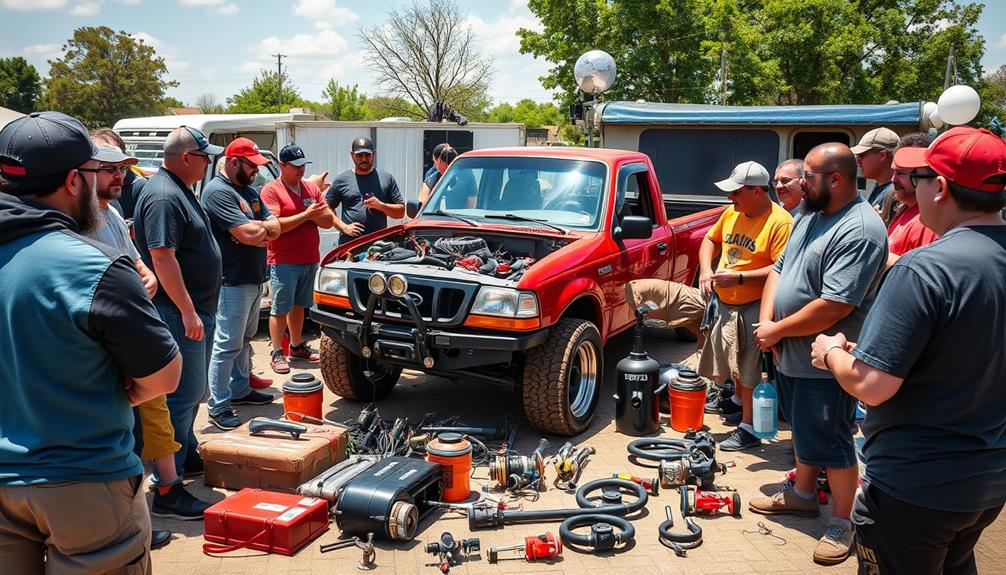
How can you guarantee you're getting the best performance from your Ford Ranger's tuning? First, it's essential to find a knowledgeable tuner, especially for older 4.0 OHV Ranger models.
Generic tuning options often fall short, leading to subpar results. Many users have shared their experiences, noting that while some plug-in tuners might disappoint initially, custom reflashes from reputable tuners can lead to significant performance gains and improved drivability.
When you engage in community discussions, you'll notice members frequently report enhanced acceleration times. For instance, performance tunes have shown a 0.7 second improvement in 40-70 mph acceleration using 87 octane fuel.
If you're willing to use premium fuel (93 octane), you can experience even better results, allowing for more aggressive spark timing adjustments and improved engine responsiveness.
Continuous feedback from the community is invaluable for making informed decisions about your tuning options.
Performance Monitoring Devices
Performance monitoring devices are essential tools for any Ford Ranger owner looking to optimize their vehicle's performance. These devices provide real-time data on drivetrain parameters, helping you track the health of your engine, transmission, cooling, and fuel systems without necessarily boosting power or efficiency.
Here's a quick overview of the key features of performance monitoring devices:
| Feature | Description |
|---|---|
| Real-time Data | Monitors engine health and other parameters. |
| DTC Reading | Identifies and resolves issues in modified vehicles. |
| Data Logging | Analyzes engine performance metrics over time. |
| Auxiliary Sensors | Tracks additional parameters like EGT and oil pressure. |
With advanced performance devices, you can also enjoy data logging capabilities, which allow for detailed analysis of your engine's performance metrics. Plus, supplemental auxiliary sensors can be added for even more insights. Mounting options guarantee that your performance monitoring devices remain visible and maintain a factory-style appearance in your truck's interior, enhancing both usability and aesthetics. Investing in these devices is a smart move for optimizing your Ranger's performance.
Detailed Tuning Process

Tuning your 2000 Ford Ranger 4.0 OHV can considerably enhance both its performance and efficiency.
The detailed tuning process involves several key adjustments to guarantee you get the most out of your truck. Here's a breakdown of what you'll typically focus on:
- Fuel Tables: Adjust these to optimize the air-fuel mixture for better combustion.
- Ignition Timing: By using premium fuel (93 octane), you can make more aggressive spark timing adjustments, enhancing power output.
- Torque Converter Settings: Modifying these can help improve responsiveness and drivability.
- Shift Points: Altering the shift strategies and pressures will lead to firmer shifts and higher RPM engagement, which markedly improves overall performance.
A custom reflash from a knowledgeable tuner can result in quicker shifts and better engine responsiveness compared to generic chips.
After tuning, you can expect average fuel economy improvements of 0.5 to 1 mpg in city driving, along with noticeable acceleration gains across various speeds.
This detailed tuning process not only makes your Ford Ranger more powerful but also more efficient on the road.
Compliance and Regulations
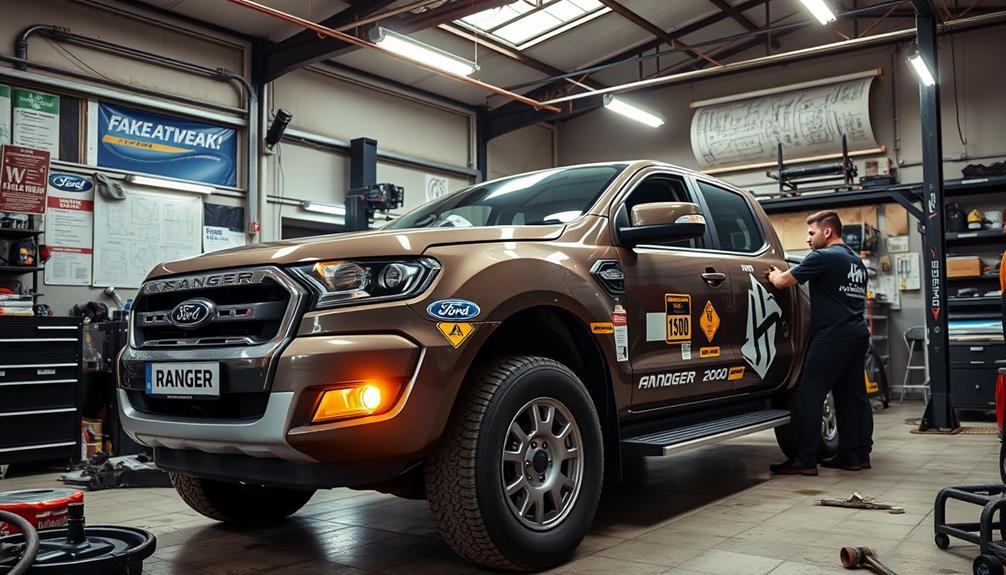
When tuning your Ford Ranger, you need to take into account emissions standards that could limit your options.
It's your responsibility to guarantee that any modifications comply with local laws, especially in states like California.
Failing to follow these regulations can lead to fines and make your vehicle illegal for use on public roads.
Emissions Standards Impact
Emissions standards play an essential role in how you can modify your 2000 Ford Ranger.
These regulations guarantee that any tuning you do keeps your emissions system intact, especially in states like California where modifications can be strictly limited.
To help you navigate these regulations, consider the following key points:
- Keep Emissions Components: Always guarantee that components like O2 sensors and the EGR valve remain connected during tuning.
- Avoid Emissions Deletes: Custom tunes should never include emissions deletes or modifications to stay compliant.
- Be Aware of Inspections: Non-compliance can lead to fines and the inability to pass vehicle inspections, which can hinder your truck's usability.
- Choose Suitable Tuning Products: Look for tuning products designed to optimize performance without compromising emissions standards, guaranteeing your truck remains legal on public roads.
Legal Compliance Requirements
Maneuvering the legal landscape of tuning your 2000 Ford Ranger requires a clear understanding of compliance and regulations. When considering modifications, especially to your exhaust system, it's essential to guarantee that all tuning devices comply with emissions regulations. This means you can't disable critical components like O2 sensors or check engine light systems.
Additionally, having a solid grasp of common financial terms can help you budget for potential tuning expenses effectively.
If you're in California, be aware that custom tuning options are severely limited due to stringent emissions laws. You're responsible for confirming that any modifications align with your local emissions laws, so you avoid penalties and keep your vehicle legal.
Remember, the EGR valve must remain connected during tuning to meet emissions standards, which might restrict some tuning options.
Failure to comply with these regulations can lead to legal issues and problems with vehicle registration, making it important to stay informed about the laws in your area.
Always consult with professionals who understand the specific compliance requirements for your Ranger. With the right knowledge and careful planning, you can enjoy enhanced performance without running afoul of the law.
Frequently Asked Questions
How Much HP Can a Ford Ranger Make?
A Ford Ranger can make around 160 horsepower from the factory. However, with proper tuning and modifications, you could boost it to 200-220 horsepower, depending on the upgrades and tuning quality you choose.
How to Make a Ford Ranger 2.3 Faster?
You can boost your Ford Ranger 2.3's speed considerably—adding a performance tuner might give you up to 50 whp! Combine that with a cold air intake and a high-flow downpipe for even more gains.
What Is the Weakness of the Ford Ranger?
The Ford Ranger's weaknesses include limited tuning potential, factory settings that often underperform, and a lack of plug-in tuners for older models. These factors can lead to engine hesitation and less responsive drivability.
What Is the Engine That Powers All Ranger Models?
Isn't it fascinating how each Ranger model comes equipped with a powerful engine? All Rangers, including the 2000, feature the robust 4.0L OHV V6, delivering solid horsepower and torque for your driving adventures.
Conclusion
To sum up, tuning your 2000 Ford Ranger can transform it into a beast that roars down the road with unmatched power and precision. By exploring the various tuning options and understanding the detailed processes involved, you're setting the stage for incredible performance gains. Don't forget to engage with the community for invaluable tips and experiences. With the right approach, your Ranger won't just perform; it'll leave everything else in the dust! Get started on your tuning journey today! With classic truck performance enhancements, your 2000 Ford Ranger can achieve even greater power and agility on the road. From upgrading the engine and exhaust system to fine-tuning the suspension and transmission, there are numerous avenues to explore for maximizing the potential of your vehicle. By staying informed and taking the time to research and experiment, you can truly unlock the full capabilities of your Ranger.
Alex is our go-to expert on performance tuning, with over a decade of experience in the automotive industry. His deep understanding of engine dynamics, exhaust systems, and performance software allows him to break down complex concepts into easy-to-follow guides. Whether you’re looking to boost horsepower or fine-tune your vehicle’s responsiveness, Alex’s insights will help you achieve peak performance.
Ford Tuning
Ford Escape 2015 Tuning: Boosting Power and Efficiency in Your Modern SUV
Improve your 2015 Ford Escape’s power and efficiency with tuning options that leave you wanting to discover the full potential of your SUV.

Tuning your 2015 Ford Escape can greatly boost both power and efficiency, making your SUV more enjoyable to drive. With options like custom tunes from Livernois Motorsports and SCT tuners, you can enhance your 2.0L Ecoboost engine, potentially increasing power by over 36 WHP and improving fuel efficiency by up to 15%. Upgrades like throttle enhancers and performance air intakes further refine your driving experience. Installing these tuners is straightforward and typically takes around 15 minutes. As you enhance performance, you'll enjoy smoother acceleration and better overall handling—discover how these improvements can transform your SUV journey.
Key Takeaways
- Tuning the 2015 Ford Escape, especially the 2.0L Ecoboost engine, can yield power gains of over 36 WHP and 77 WTQ.
- Custom tuning options from Livernois Motorsports and RaceChip enhance performance and fuel efficiency, potentially improving MPG by up to 15%.
- Installation of tuners is straightforward, typically completed in about 15 minutes with user-friendly features for DIY enthusiasts.
- Upgrading components like air intake systems and exhaust enhances airflow, further boosting engine performance.
- Regular maintenance and proper tuning can extend engine longevity while providing an engaging driving experience.
Overview of Ford Escape Tuning
Tuning your 2015 Ford Escape can really boost its performance and transform your driving experience. With its 2.0L Ecoboost engine, you've got a solid foundation for tuning that can greatly enhance horsepower and torque.
By choosing the right tuning options, like custom tunes from Livernois Motorsports or Torrie from Released Tuning, you can expect impressive performance gains. Just remember to verify your PCM serial number for the best results.
Through proper tuning, you could see increases of over 36WHP and 77WTQ, with max gains potentially exceeding 46WHP and 83WTQ when opting for a performance tune.
Aftermarket tuning devices, such as the SCT tuner, allow you to fine-tune fuel mapping and ignition timing, improving both throttle response and overall drivability.
However, it's vital to approach tuning with care. Proper methods are essential to avoid any risk of engine damage.
Engaging with community discussions and shared experiences can provide valuable insights that enhance your tuning process. By understanding the various aspects of tuning for your Escape, you'll set yourself up for a more powerful and efficient ride.
Benefits of Tuning Your SUV
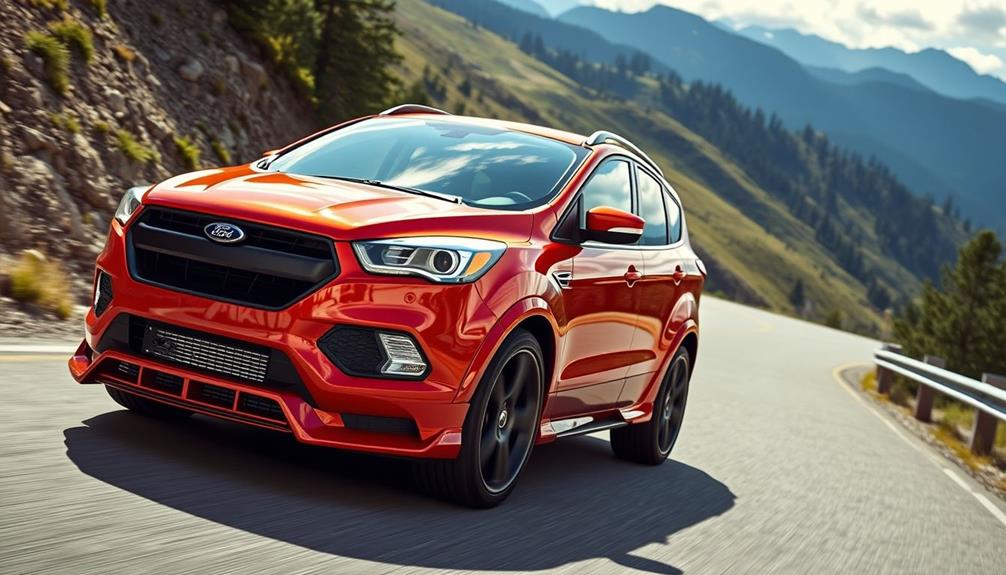
Enhancing your 2015 Ford Escape through tuning brings a multitude of benefits that go beyond just increased horsepower and torque. You can expect significant gains, with potential improvements of over 36WHP and 77WTQ. This boost in power levels translates into better acceleration and overall performance, making every drive more exhilarating.
Custom tuning options allow you to tailor your Escape's performance to match your driving style. Whether you prefer spirited drives or fuel-efficient commuting, tuning can adjust your power levels to meet those needs. Improved throttle response and shifting dynamics also make your SUV feel more engaging and responsive, enhancing drivability in everyday conditions.
One of the most appealing benefits is the potential for better fuel efficiency. With some modifications, you might see an improvement of up to 15% in MPG, leading to noticeable cost savings at the pump.
Additionally, advanced tuning technology, such as data logging capabilities, enables real-time performance monitoring and adjustments. This guarantees that your engine runs at peak performance, contributing to its longevity.
Key Performance Upgrades
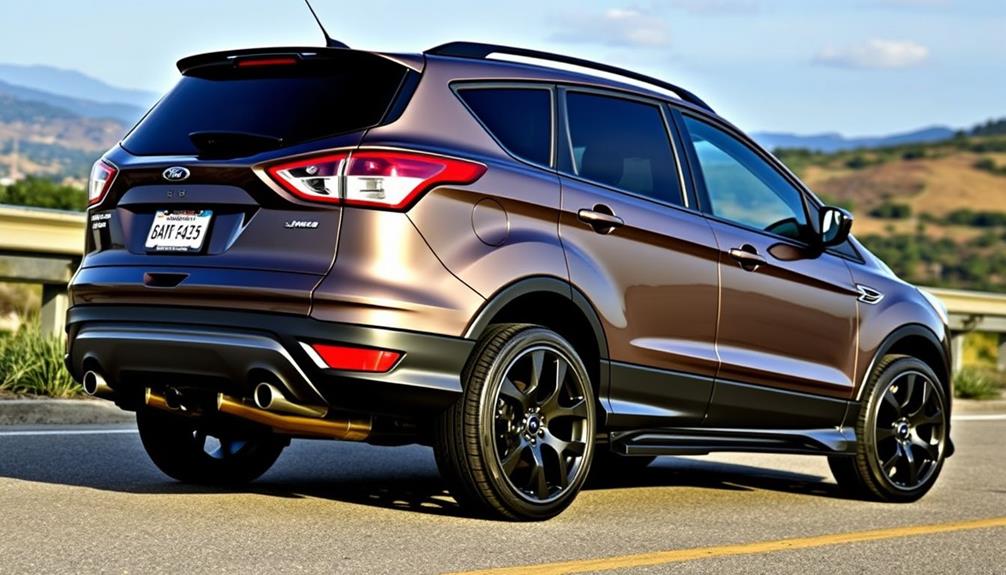
When it comes to releasing your 2015 Ford Escape's full potential, key performance upgrades can make a world of difference. One of the most impactful upgrades is a custom tune, like those offered by Livernois Motorsports. With a performance tune using 93 octane fuel, you can gain up to 36 horsepower and 77 lb-ft of torque, enhancing your driving experience greatly.
In addition to power gains, proper tuning optimizes fuel mapping and air/fuel management, which can boost your fuel economy by as much as 15%. This means you not only enjoy a more powerful ride but also save at the pump.
You might also consider adding the Livernois Motorsports Infinite+ Throttle Enhancer, which improves throttle response for better acceleration and responsiveness.
With additional tune options available, you can customize your Escape's performance further, with prices ranging from just $10 for one extra tune to $40 for four.
These key performance upgrades guarantee that you maximize both power and efficiency in your Ford Escape, giving you a more enjoyable and economical driving experience.
Tuning Options and Customization

When it comes to tuning your Ford Escape, you've got some exciting options to explore.
From the Livernois Motorsports MyCalibrator Touch's performance tunes to RaceChip's adaptable mappings, you can greatly enhance your ride's performance.
Plus, customization features allow you to tailor your tuning strategy to fit your driving style and needs.
Available Tuning Options
Exploring the available tuning options for the 2015 Ford Escape reveals a range of customizable solutions designed to enhance performance and efficiency. One standout choice is the Livernois Motorsports MyCalibrator Touch, which offers a 93 octane performance tune. This option can deliver impressive gains of over 36 WHP and 77 WTQ, making it a top pick for those serious about boosting their SUV's power.
You can also expand your tuning flexibility with additional options. For just $10, you can add one more tune, or for $40, you can gain access to four additional tunes.
If you're looking for a different approach, RaceChip tuning provides various performance levels, from the solid RaceChip S to the premium RaceChip GTS Black. The latter can potentially improve your MPG by up to 15%.
Installing these tuning devices is usually straightforward, thanks to the Plug&Drive principle. This ease of installation means even DIY enthusiasts can take on the task with minimal effort.
Plus, with data logging capabilities, you can monitor performance metrics and make real-time adjustments for peak engine performance based on specific driving conditions.
Customization Features Explained
Releasing the full potential of your 2015 Ford Escape is easy with a variety of customization features designed to enhance your driving experience.
One standout option is the MyCalibrator Touch, which provides multiple tuning levels tailored for both gasoline performance and towing. This means you can fine-tune your Escape for any occasion.
If you want to expand your tuning capacity, you can purchase additional options, starting from just $10 for an extra tune up to four tunes for $40. This flexibility allows you to cater your tuning to specific performance needs.
Moreover, the customization features include data logging capabilities, enabling you to track performance metrics and adjust your settings for ideal results based on your preferences and driving conditions.
With support from Livernois Motorsports, you get expert help with fuel mapping, air/fuel management, and revised boost control, all aimed at improving power delivery.
As a result, you'll experience enhanced throttle response and improved shifting, creating a more engaging driving experience while boosting efficiency in your 2015 Ford Escape.
Performance Enhancement Strategies
Releasing the full potential of your 2015 Ford Escape goes beyond basic customization; it involves implementing various performance enhancement strategies.
One effective option is the Livernois Motorsports MyCalibrator Touch, which offers tuning levels that can deliver peak gains of over 36 WHP and 77 WTQ with a 93 octane performance tune. If you want a more tailored approach, custom tuning options allow you to select additional tunes for specific performance needs, with prices as low as $10.
Another valuable enhancement is the Pedal Commander device, which improves throttle response and acceleration. It offers multiple driving modes, including ECO and Sport, optimizing your driving experience without altering the vehicle's horsepower.
For those seeking even more power, RaceChip tuning modules provide various performance levels, from the RaceChip S to the RaceChip GTS Black, allowing you to fine-tune your Escape's capabilities.
Installation Process for Tuners
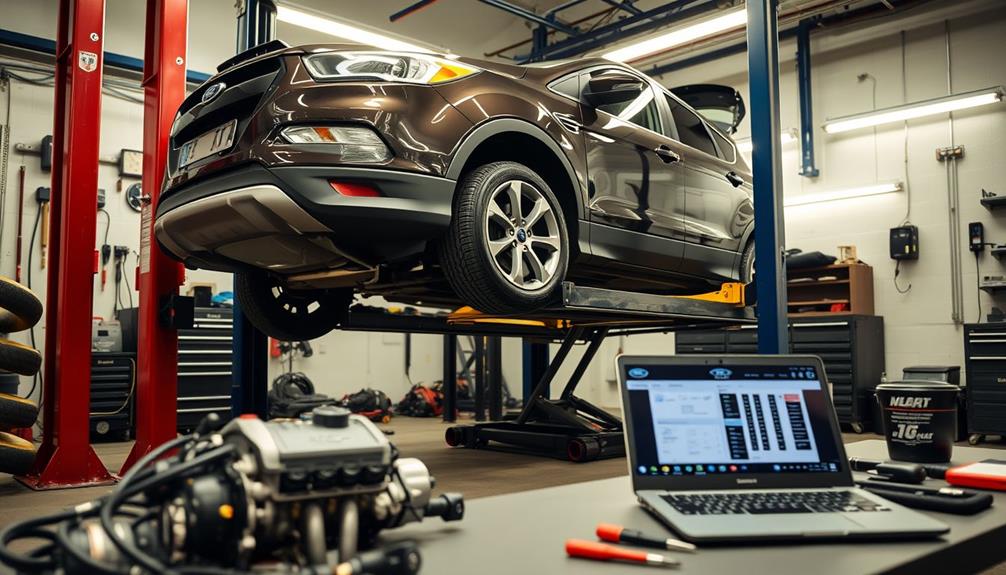
Installing a tuner for your 2015 Ford Escape is a straightforward process that typically takes just about 15 minutes. Most tuners follow a Plug&Drive principle, allowing you to set it up with minimal hassle. First, locate your engine codes in your service booklet or on engine bay stickers; this guarantees your tuning device is compatible.
Here's a quick overview of the installation process for tuners:
| Step | Description | Time Estimate |
|---|---|---|
| 1. Gather Tools | Collect necessary tools and tuning device. | 2 minutes |
| 2. Connect Device | Plug the tuner into the OBD-II port. | 5 minutes |
| 3. Software Update | Follow instructions for any software updates. | 8 minutes |
Most tuners come with detailed fitting instructions and wiring kits to guarantee a secure installation. If you encounter any issues, technical support is typically available, making this process accessible even for those without extensive mechanical experience. Plus, you can enjoy real-time fine-tuning options via mobile apps, allowing you to adjust performance settings conveniently.
Understanding Powertrain Warranty

When considering a powertrain warranty for your Ford Escape, it's vital to understand what it covers and any limitations that may apply.
This warranty typically protects essential components like the engine and transmission, but there are exclusions you should be aware of.
Knowing these details can help you make informed decisions, especially if you're planning on tuning your vehicle.
Warranty Coverage Details
Understanding the nuances of the Ford Escape's powertrain warranty can be essential for your peace of mind, especially if you're considering tuning your vehicle. The optional Limited Powertrain Warranty is priced at $1,000.00 but can be snagged for a reduced price of $599.99, providing coverage for vital powertrain components. This warranty isn't available in California due to state regulations, so keep that in mind.
Having this warranty coverage is a great way to protect yourself against potential failures, especially after tuning your Escape for enhanced performance. Depending on the options you select, the coverage can last from 2 to 5 years, which boosts your confidence in your vehicle's capabilities.
Here's a quick overview of the warranty options:
| Warranty Option | Price | Coverage Duration |
|---|---|---|
| Standard Powertrain | $1,000.00 | 2 to 5 years |
| Discounted Powertrain | $599.99 | 2 to 5 years |
| California Availability | N/A | N/A |
| Protection Against Failures | Yes | Yes |
With this warranty, you can feel secure while enjoying your tuned Ford Escape.
Limitations and Exclusions
While having warranty coverage can provide peace of mind after tuning your Ford Escape, it's important to be aware of its limitations and exclusions. The optional Limited Powertrain Warranty, which costs $1,000 or an alternative $599.99, covers essential powertrain components but has specific conditions.
For instance, this warranty isn't available for sale in California, limiting access for residents there. Additionally, the coverage typically lasts between 2 to 5 years, depending on the terms you agree upon at purchase.
However, understanding the warranty's limitations is vital. Certain modifications or tuning could void the warranty, especially if they're not performed according to manufacturer guidelines. This means that if you decide to upgrade your Escape for better performance, any non-compliant modifications might leave you without coverage if issues arise.
To protect your investment and guarantee you're covered, always consult the warranty details and consider how your tuning choices might affect it. Being informed about these exclusions can save you from unexpected repair costs down the line, helping you maintain both power and peace of mind.
Fuel Efficiency Improvements

Tuning your 2015 Ford Escape can greatly boost fuel efficiency, helping you save at the pump. By optimizing your engine's performance, you can achieve fuel efficiency improvements of up to 15%.
One effective way to enhance fuel economy is through a performance tune that optimizes air/fuel management and ignition timing. This not only increases your MPG but also reduces harmful emissions.
Replacing faulty components, like an oxygen sensor, can further elevate your fuel mileage by up to 40%. Regular maintenance and tuning are essential, as they can enhance overall vehicle efficiency by as much as 25%, ensuring your engine operates at peak performance levels.
Aftermarket tuning options provide an excellent opportunity to achieve these gains without sacrificing power. With improvements in fuel mapping, your Escape will use fuel more efficiently, allowing you to enjoy a smoother driving experience.
Incorporating these tuning measures means you're not just enhancing your SUV's performance; you're also making a positive impact on your wallet and the environment.
Enhancing Throttle Response
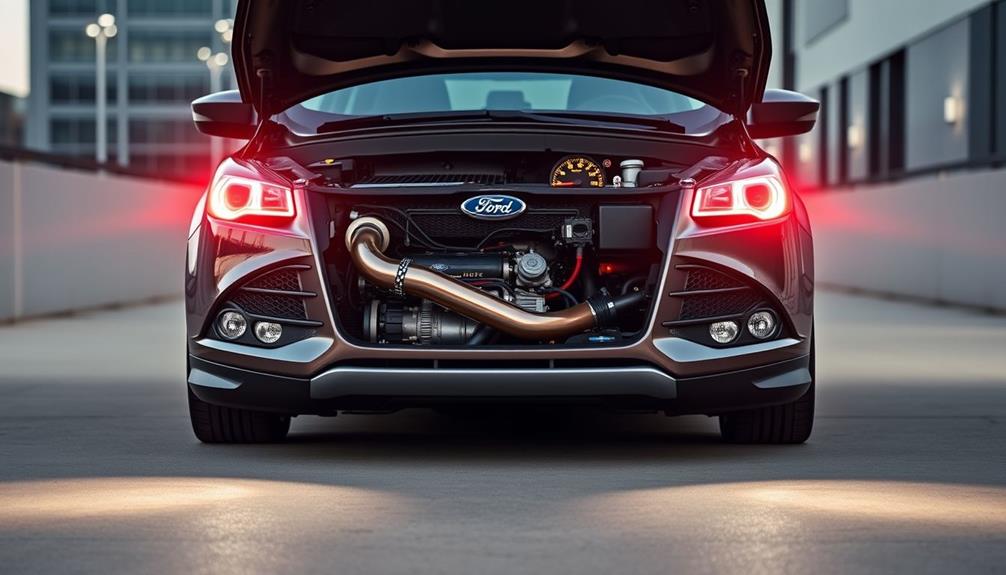
Enhancing throttle response in your 2015 Ford Escape dramatically boosts drivability, making acceleration quicker and driving more engaging. By upgrading to a Livernois Motorsports Infinite+ Throttle Enhancer, you've got precise control over throttle response, optimizing your vehicle's performance for various driving conditions.
This upgrade not only transforms how your SUV feels but also enhances overall efficiency.
With aftermarket tuning solutions like the MyCalibrator Touch, you can access peak gains of over 36WHP and 77WTQ, resulting in improved throttle sensitivity. These gains allow for a more responsive driving experience, whether you're maneuvering city streets or cruising on the highway.
Custom tuning options enable you to tailor your vehicle's throttle response to your preferences, ensuring that your Escape delivers the performance you desire.
Moreover, enhancing throttle response contributes to better fuel efficiency by allowing smoother power delivery during driving. This means you can enjoy a lively driving experience without sacrificing economy.
Maintaining Engine Longevity
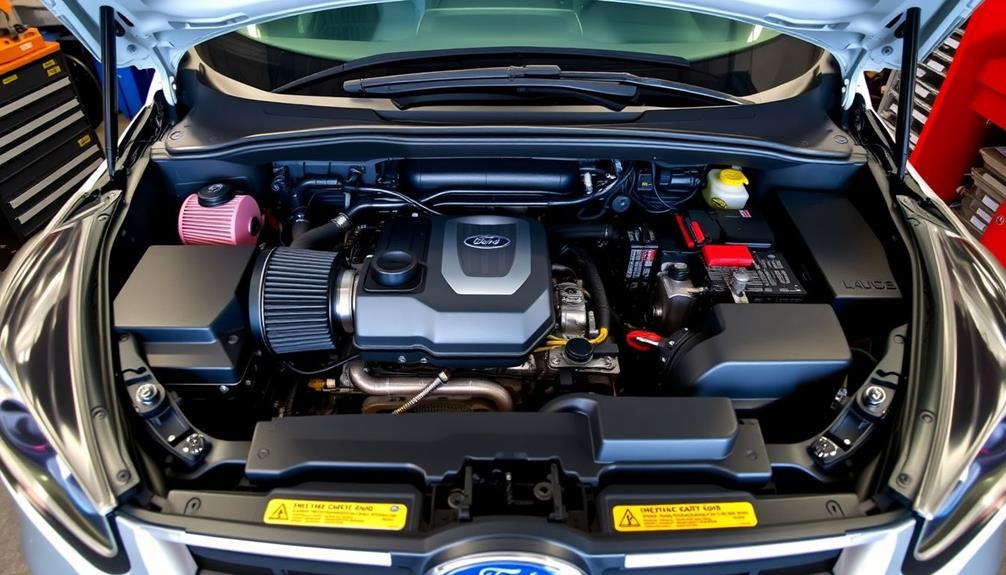
To guarantee your 2015 Ford Escape runs smoothly for years to come, regular maintenance is key. By prioritizing tasks that support maintaining engine longevity, you can avoid expensive repairs and enjoy better performance. Here's a quick overview of essential maintenance tasks:
| Maintenance Task | Importance | Frequency |
|---|---|---|
| Engine Tuning | Improves fuel mileage by up to 4% | Every 5,000 miles |
| Change Fuel Filters | Essential for peak engine health | Every 15,000 miles |
| Replace Spark Plugs | Boosts efficiency, up to 25% gain | Every 30,000 miles |
Implementing a Warm-Up Timer feature helps your engine reach peak performance without the risk of premature wear during cold starts. Additionally, make sure you're using the manufacturer's recommended oil grade—using the wrong type can decrease fuel economy by up to 2%. Regularly check your tire pressures, as proper inflation enhances safety and can improve fuel economy.
Recommended Tuning Products
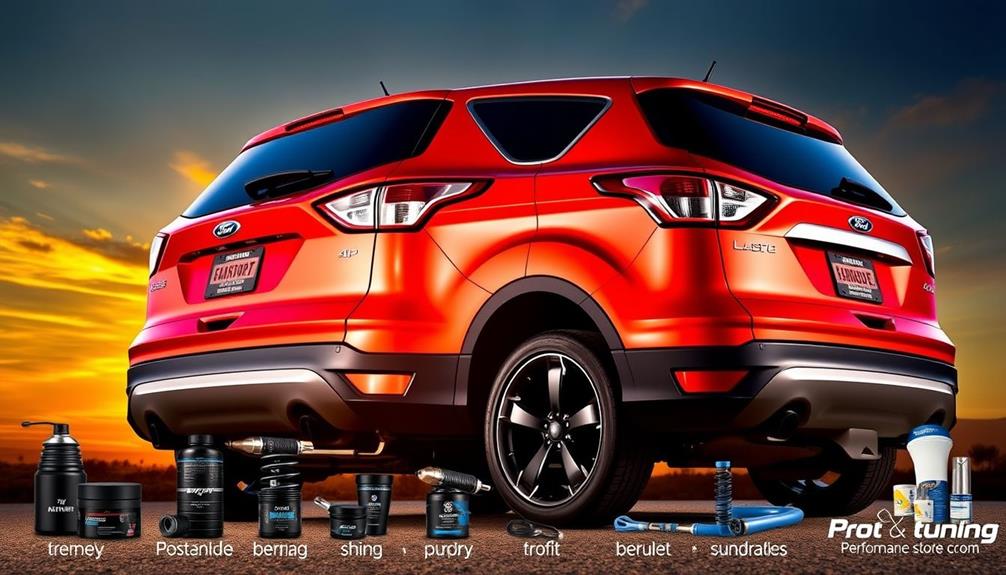
When looking to boost your 2015 Ford Escape's performance, several recommended tuning products can make a significant difference. One standout option is the Livernois Motorsports Infinite+ Throttle Enhancer, priced at $299.99. This product enhances throttle response and overall drivability, providing a more engaging driving experience.
Another excellent choice is the MyCalibrator Touch, which offers multiple tuning levels. With a performance tune, you can achieve peak gains of over 36WHP and 77WTQ. Plus, you can expand your tuning options with additional tunes starting from just $10.00.
If you're considering a thorough upgrade, RaceChip models like the GTS Black deliver impressive results. These chips can boost performance by up to 15% in MPG while increasing horsepower and torque to match your specific driving conditions.
For added peace of mind, consider the optional Limited Powertrain Warranty, available for $1,000.00 or $599.99, which covers powertrain components after modifications.
Investing in these recommended tuning products will guarantee your Ford Escape not only performs better but operates efficiently, enhancing your overall driving experience.
Frequently Asked Questions
How Much Horsepower Does a 2015 Ford Escape 2.0 Ecoboost Have?
The 2015 Ford Escape with the 2.0L Ecoboost engine produces about 240 horsepower. You'll appreciate its turbocharged design, which enhances performance while maintaining fuel efficiency, making it a great choice for various driving conditions.
Is the 2015 Ford Escape Fuel Efficient?
You might think fuel efficiency's just average, but the 2015 Ford Escape actually impresses. With the right maintenance and tuning, you can enjoy up to 15% better mileage, enhancing both your driving experience and savings.
What Is the Best Engine in the 2015 Ford Escape?
You'll want the 2.0L EcoBoost engine for the 2015 Ford Escape. It delivers 240 horsepower and 270 lb-ft of torque, offering the best combination of power and efficiency for your driving experience.
How Much Power and Torque Does a Ford Escape Have?
When you consider a Ford Escape, you'll discover different engine options delivering diverse dynamics. The 2.5L produces 168 horsepower, while the 2.0L EcoBoost boasts a powerful 240 horsepower and impressive torque at 270 lb-ft.
Conclusion
To sum up, tuning your 2015 Ford Escape is like fine-tuning a musical instrument; it brings out the best in your ride. Imagine transforming your SUV from a simple melody into a symphony of power and efficiency. With the right tweaks, you'll not only enjoy a boost in performance but also experience smoother handling and better fuel economy. So, don't hesitate—unlock your Escape's true potential and hit the road with a newfound rhythm!
Alex is our go-to expert on performance tuning, with over a decade of experience in the automotive industry. His deep understanding of engine dynamics, exhaust systems, and performance software allows him to break down complex concepts into easy-to-follow guides. Whether you’re looking to boost horsepower or fine-tune your vehicle’s responsiveness, Alex’s insights will help you achieve peak performance.
Ford Tuning
Ford Explorer 2010 Tuning: Maximizing Power in Your Midsize SUV
Jumpstart your 2010 Ford Explorer’s performance with tuning tips that promise exhilarating power boosts—discover what upgrades can transform your ride!
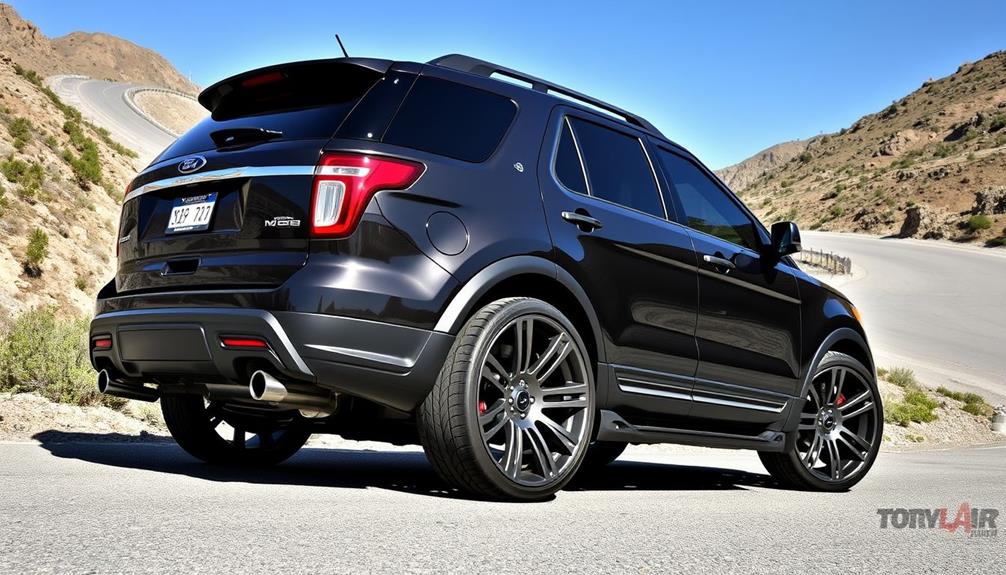
Tuning your 2010 Ford Explorer can greatly boost its power and performance. Start with a supercharger for a massive horsepower increase—over 130 hp! Pair it with a performance exhaust system and a cold air intake to enhance airflow, leading to even more gains. Don't forget about a custom tune to optimize your engine's operation. Regular maintenance, like cleaning the throttle body and installing an oil catch can, will keep your engine running smoothly. Investing wisely in these upgrades can turn your Explorer into a thrilling ride. Keep exploring your options for more strategies to maximize your SUV's potential.
Key Takeaways
- Install a cold air intake to enhance airflow, yielding up to 15 HP and improving torque for better acceleration.
- Upgrade to a performance exhaust system to increase exhaust flow, reducing back pressure and enhancing engine efficiency and sound.
- Consider forced induction with a supercharger for a significant boost of over 130 horsepower and improved torque for powerful performance.
- Utilize a custom tune to optimize engine operation, maximizing horsepower and torque tailored to your specific modifications.
- Regular maintenance, including installing an oil catch can and cleaning the throttle body, preserves engine performance and reliability.
Vehicle Modifications Overview
When it comes to tuning your 2010 Ford Explorer, what modifications can truly elevate its performance? First up, consider forced induction. Installing a supercharger can add over 130 horsepower, transforming your SUV into a powerhouse.
Next, upgrading to a performance exhaust system, like a Catback exhaust, helps improve exhaust flow and reduces back pressure. This not only boosts horsepower but also gives your Explorer a more aggressive sound.
You can't overlook the importance of a cold air intake. This modification enhances airflow to the engine, leading to measurable gains in both horsepower and torque. It's a critical step for performance enthusiasts looking to maximize their vehicle's potential.
After making these changes, incorporating a high-pressure fuel pump and injectors guarantees peak fuel flow, keeping your air-fuel ratio in check for maximum power output.
Lastly, don't forget about regular maintenance. Cleaning the throttle body and installing an oil catch can can help preserve your engine's performance and longevity, especially when you've added performance parts.
With these modifications, you'll be well on your way to revealing the full potential of your Ford Explorer.
Performance Improvement Insights
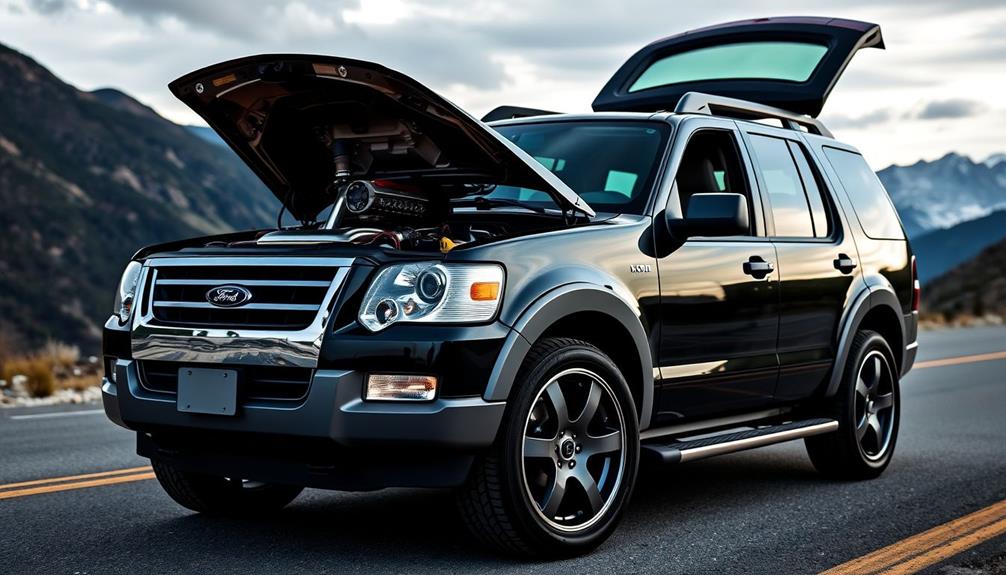
If you want to see significant power gains in your 2010 Ford Explorer, you'll need to go beyond simple bolt-on upgrades.
Extensive modifications, including a custom performance tune and upgraded fuel system, are key to revealing the full potential of your engine.
Significant Power Gains
Releasing significant power gains in your 2010 Ford Explorer is an exciting journey that can transform your driving experience. One of the most effective ways to boost performance is through a custom tune, which maximizes your engine's operation for enhanced horsepower and torque.
With the right tuning, you can improve fuel efficiency while enjoying a more responsive ride.
For even more substantial gains, consider installing a supercharger. This modification can increase horsepower by around 130 at the wheels, giving your SUV the adrenaline rush you crave.
Don't forget about fuel injectors; upgrading to high-performance fuel injectors is essential for supporting these enhanced components and maintaining ideal air-fuel ratios.
Additionally, a cold air intake, like the AFE Momentum GT, can yield up to 15 HP and 17 lbs. x ft. of torque, further enhancing engine efficiency.
Pairing this with a performance exhaust system, such as the Corsa 2.5 Sport Cat Back, can reduce back pressure and increase airflow by 74%.
These modifications, alongside a custom tune, will help you achieve significant power gains and elevate your Ford Explorer's performance to new heights.
Comprehensive Modifications Needed
To truly release the potential of your 2010 Ford Explorer, a thorough approach to modifications is essential. Extensive modifications, like forced induction and performance tuning, can greatly improve your SUV's performance. Minor bolt-on mods typically offer a mere 5 horsepower increase, but upgrading to a supercharger along with a custom performance tune can yield up to 130 wheel horsepower.
Key upgrades include a high-pressure fuel pump and upgraded injectors to maintain ideal air-fuel ratios, ensuring you maximize any performance gains. Additionally, installing a performance exhaust system can considerably enhance engine efficiency by reducing back pressure, leading to improved power output and a more aggressive sound.
Here's a quick overview of essential modifications:
| Modification Type | Benefits | Impact on Fuel Economy |
|---|---|---|
| Supercharger | Up to 130 hp gain | May slightly reduce economy |
| High-pressure fuel pump | Ideal air-fuel ratios | Neutral |
| Performance exhaust system | Enhanced engine efficiency | Improved |
| Cold air intake | Increased airflow | Slightly improved |
Cost Considerations for Upgrades
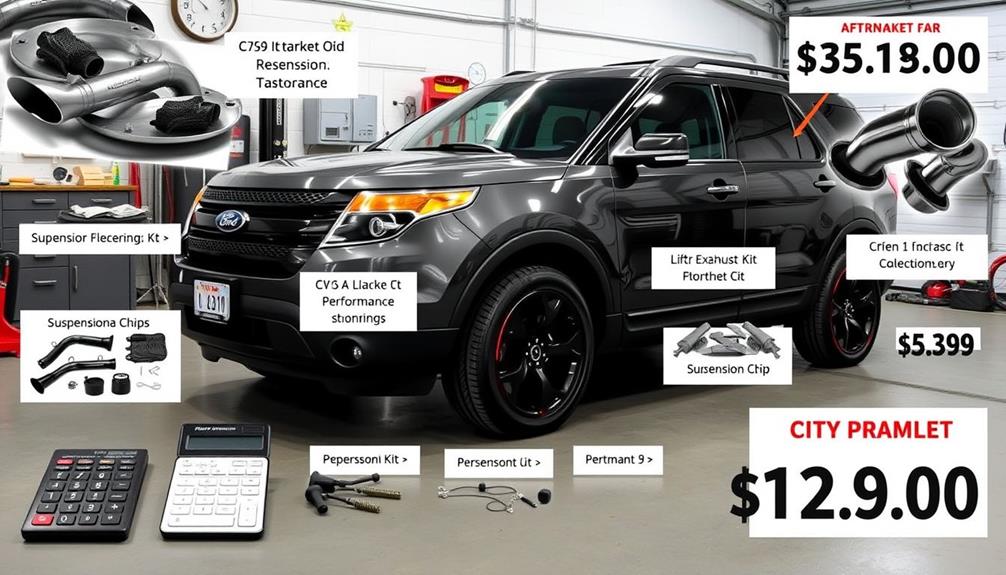
When considering upgrades for your 2010 Ford Explorer, it's important to keep costs in mind from the outset. Performance modifications can get pricey, with budgets sometimes exceeding $10,000 for significant enhancements like superchargers and custom tuning.
If you're aiming to increase power, you might find that investing in a newer V8 model could provide better performance and reliability compared to extensive modifications on your current vehicle, ultimately saving you money in the long run.
Don't forget about the costs associated with nitrous refills, which can add up quickly, making it less practical for daily driving.
For those of you looking at gradual upgrades, this approach allows for better financial planning, spreading out costs over time and preventing any budgetary surprises.
While minor bolt-on modifications might seem appealing, they typically yield only minimal horsepower gains—around 5hp.
Thus, if you're serious about boosting your Explorer's performance, thorough upgrades are necessary. Keep these cost considerations in mind to guarantee that your investment in performance modifications pays off in the long run.
Importance of Vehicle Maintenance

Maintaining your 2010 Ford Explorer is crucial for guaranteeing it runs smoothly and efficiently. Regular maintenance, like cleaning the throttle body, can restore lost power and enhance overall engine performance. A clean throttle body helps optimize fuel flow and combustion efficiency, which leads to better fuel economy.
Additionally, implementing a preventive maintenance plan can markedly extend the lifespan of your vehicle's components.
Consistent upkeep, including timely oil changes and tire rotations, greatly contributes to the longevity and reliability of your vehicle. An oil catch can is especially important for high-performance builds, as it prevents oil blow-by from entering the intake system, reducing carbon buildup and improving engine reliability.
Upgrading components, such as new tires or rebuilt transmissions, not only enhances your driving experience but also guarantees better handling and safety on the road.
Additionally, regular inspections of performance modifications—like shocks and sway bars—help maintain their effectiveness and prolong their lifespan, contributing to overall vehicle performance.
Community Insights and Support
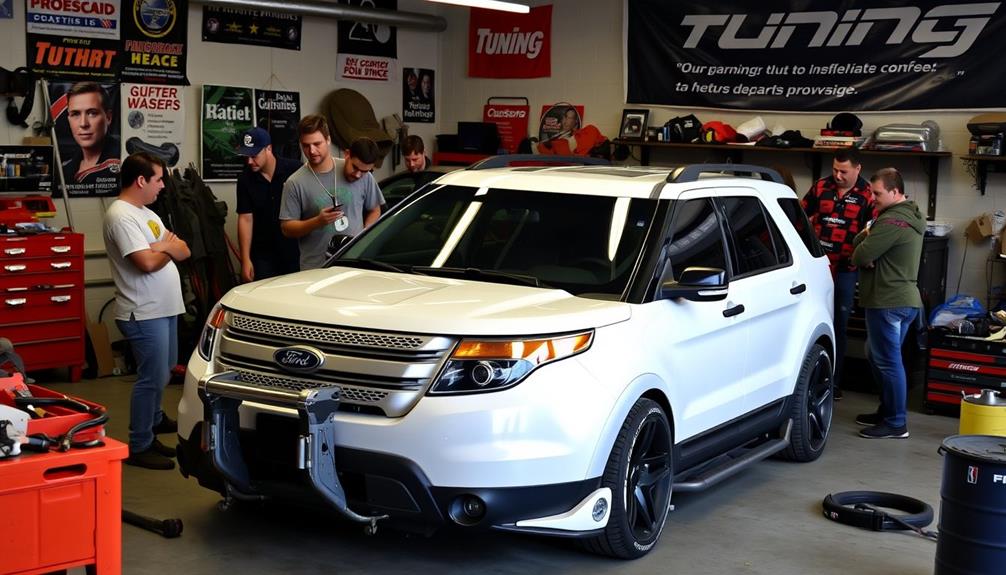
How can you tap into the wealth of knowledge within the Ford Explorer community? Engaging with online forums is a fantastic way to connect with fellow enthusiasts who share valuable experiences and advice on tuning and modifications.
You'll find that many members post success stories about their performance upgrades, providing both inspiration and guidance for your own projects. These discussions often explore deep into specific modifications, offering detailed insights that can help you make informed decisions.
Whether you're looking to enhance your engine's power or improve handling, you'll benefit from the collective experiences of others who've been down that path before. Community support is vital, especially when troubleshooting issues during your tuning processes.
Members are enthusiastic to share solutions and best practices, ensuring you don't have to navigate challenges alone. Plus, by participating in these discussions, you can foster connections with other enthusiasts, which may lead to collaborative projects and the exchange of tips for maximizing your 2010 Ford Explorer's performance.
Immerse yourself in the community; it's a treasure trove of knowledge waiting for you!
Key Performance Upgrades
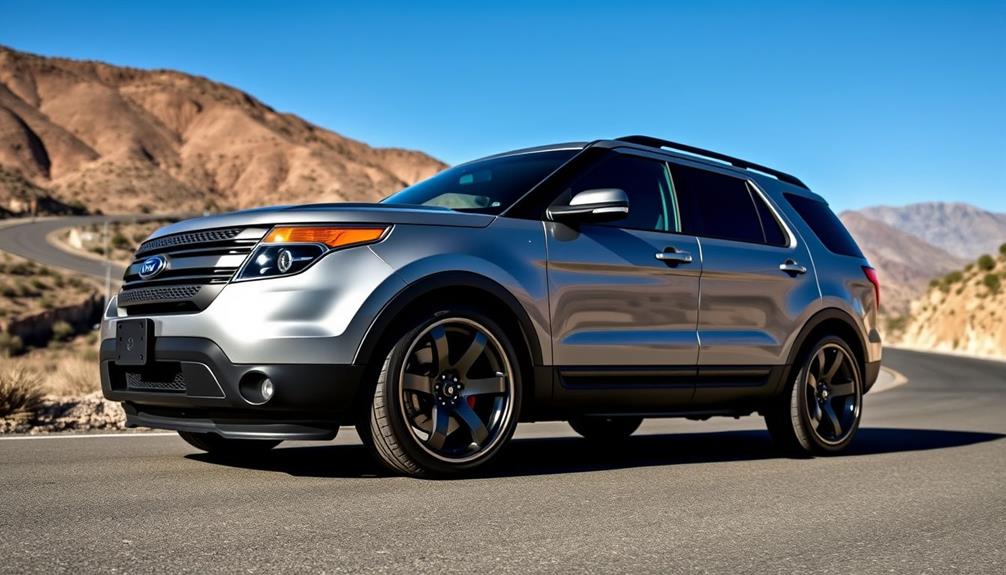
When you're looking to boost your Ford Explorer's performance, consider installing a supercharger for significant horsepower gains.
Pair that with exhaust and intake enhancements, and you'll notice a marked improvement in engine response and sound.
These upgrades not only elevate your driving experience but also maximize your vehicle's potential.
Supercharger Installation Benefits
One of the most exciting upgrades you can make to your 2010 Ford Explorer is installing a supercharger, like the Edelbrock 2.3L. The supercharger installation benefits are hard to ignore, as it can boost your horsepower by over 130 hp, elevating your output from 223 to around 355 wheel horsepower.
This significant increase not only enhances your vehicle's performance but also transforms your driving experience.
With the added torque—approximately 80 ft-lbs—you'll notice improved acceleration that makes spirited driving a thrill. Your engine will efficiently reach higher RPMs, hitting 6000 RPM without a hitch, which means you can enjoy that extra power whenever you need it.
Moreover, the installation often involves modifications like a larger throttle body, optimizing airflow and further enhancing performance. If you pair the supercharger with other upgrades, such as an electric fan and cold air intake, you'll get the best bang for your buck regarding reliability and power.
Exhaust and Intake Enhancements
Upgrading your 2010 Ford Explorer with exhaust and intake enhancements can deliver impressive performance gains. By installing a performance exhaust system, like the Corsa 2.5 Sport Cat Back, you can increase airflow by 74%, markedly reducing back pressure. This improvement enhances engine efficiency, making your SUV more fun to drive.
Combining this with a cold air intake, such as the AFE Momentum GT, can yield an extra 15 horsepower and 17 lbs. x ft. of torque, while boosting intake air flow by 27%. Cooler air entering the engine increases combustion power and throttle response, further maximizing your Explorer's performance.
| Upgrade Type | Benefits | Example Product |
|---|---|---|
| Exhaust System | 74% more airflow, reduced back pressure | Corsa 2.5 Sport Cat Back |
| Cold Air Intake | 15 HP, 17 lbs. x ft. torque increase | AFE Momentum GT |
| Combined Upgrades | Enhanced efficiency and fuel economy | N/A |
Together, these enhancements create a more efficient engine setup, leading to considerable performance gains and a thrilling driving experience. Don't miss out on transforming your Explorer into a powerhouse!
Installation Steps and Challenges

Tuning a 2010 Ford Explorer, especially with a supercharger, involves several detailed steps and challenges that require careful planning.
First, you'll need to allocate about four days for the installation process, which can cost around $10,000 plus tax and supplies.
Start with the modifications in the engine bay; replacing the stock mechanical fan with an electric fan is crucial for better cooling, and this requires removing the front bumper cover to access the heat exchanger.
Next, reconfigure the cold air intake, which means you'll have to remove the intake manifold to install the supercharger properly. You'll also need to trim radiator mounts for a dual fan setup and adjust brackets for water tanks and heat exchangers to guarantee everything fits.
During the installation steps, pay close attention to wiring adjustments for mass airflow sensors and vacuum lines.
These modifications are critical for peak performance and require precision in execution. Each step you take brings you closer to maximizing the power of your Explorer, but don't underestimate the challenges involved in this intricate process.
Component Adjustments Needed
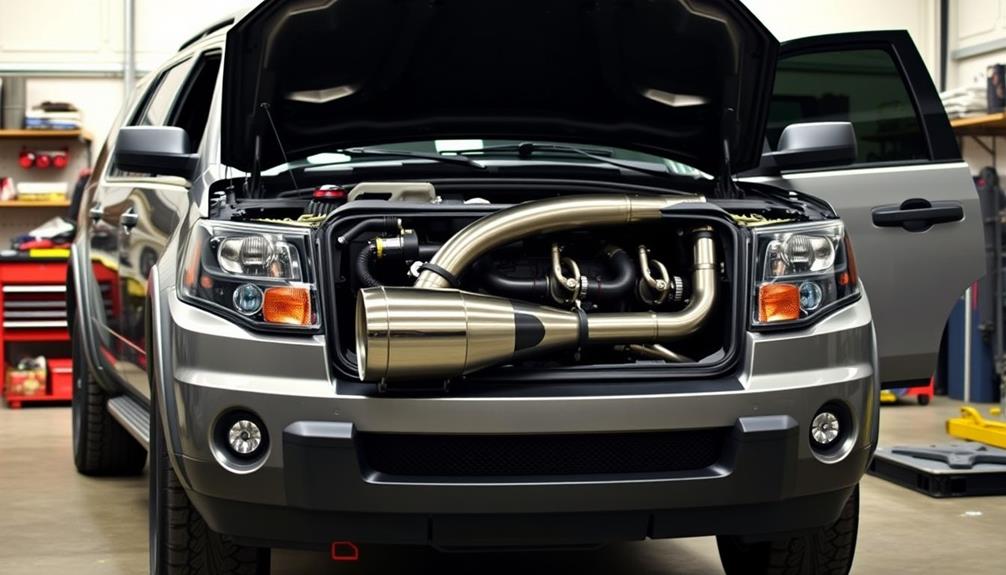
Achieving ideal performance with the 2010 Ford Explorer's supercharger installation hinges on meticulous component adjustments. First, you'll need to make modifications to the stock intake manifold to guarantee a proper fit for the Edelbrock 2.3L supercharger. This step is critical for both functionality and performance gains.
Next, you should replace the stock mechanical fan with an electric fan. This change enhances cooling efficiency and creates the necessary space for the heat exchanger, which is essential for maintaining peak engine temperatures.
You'll also need to install additional bracketry and pulleys to secure the supercharger and its related components effectively.
Pay close attention to your high-pressure power steering lines; bending them for clearance is important to avoid any interference.
Enhancing Comfort and Features

After fine-tuning the performance of your 2010 Ford Explorer, it's time to focus on enhancing comfort and features that elevate your driving experience. Upgrading interior accessories, like custom steering wheels and shift knobs, can greatly boost ergonomics, making every drive more enjoyable. You should also consider adding high-quality performance-oriented features, such as a better sound system or upgraded climate controls, to improve functionality.
In addition to these upgrades, exterior accessories like spoilers and body kits not only enhance aerodynamics but also add a distinctive visual flair to your SUV. Installing an oil catch can contributes to cleaner intake components, promoting engine longevity and reliability, which ultimately leads to a smoother driving experience. Regular maintenance of your new shocks and suspension components guarantees optimized ride quality, enhancing both daily commutes and spirited drives.
Here's a quick reference table for your upgrades:
| Upgrade Type | Benefits | Example Features |
|---|---|---|
| Interior Accessories | Enhancing comfort | Custom steering wheels |
| Performance Features | Improved functionality | Upgraded sound system |
| Exterior Accessories | Unique visual appeal | Body kits and spoilers |
| Engine Maintenance | Enhanced engine longevity | Oil catch can |
| Suspension Upgrades | Optimized ride quality | New shocks and components |
Frequently Asked Questions
What Ford Explorer Has the Most Horsepower?
If you're looking for the Ford Explorer with the most horsepower, the 2020 Explorer ST stands out. Its 3.0L EcoBoost V6 engine delivers an impressive 400 horsepower, making it the most powerful option available.
What Is the Sand Mode on a Ford Explorer?
Sand Mode on a Ford Explorer helps you drive on loose, sandy surfaces. It adjusts throttle response and traction control, optimizing performance and preventing wheel spin, so you can navigate challenging terrains with confidence and ease.
Why Is My Ford Explorer Struggling to Accelerate?
When your Ford Explorer's acceleration feels like running in quicksand, check for clogged air filters, ignition issues, or fuel delivery problems. Regular maintenance can help boost performance and get you moving smoothly again.
What Is Considered High Mileage for a Ford Explorer?
For a Ford Explorer, high mileage is generally considered over 100,000 miles. At this point, you might notice performance issues, so keeping up with maintenance and service records is essential for longevity and reliability.
Conclusion
In your quest to transform your 2010 Ford Explorer into a powerhouse, think of it as sculpting a masterpiece from a block of marble. Each modification chisels away at limitations, revealing the performance hidden within. While costs and challenges might loom like storm clouds, your dedication and passion will shine through, illuminating the path to success. Embrace the journey, connect with fellow enthusiasts, and soon you'll be cruising with a blend of power and comfort that's nothing short of extraordinary.
Alex is our go-to expert on performance tuning, with over a decade of experience in the automotive industry. His deep understanding of engine dynamics, exhaust systems, and performance software allows him to break down complex concepts into easy-to-follow guides. Whether you’re looking to boost horsepower or fine-tune your vehicle’s responsiveness, Alex’s insights will help you achieve peak performance.
Ford Tuning
Ford Edge 2011 Tuning: Transforming Your Crossover Into a Performance Beast
You won’t believe how simple upgrades can unleash your 2011 Ford Edge’s hidden power—discover the secrets to transforming your crossover today!
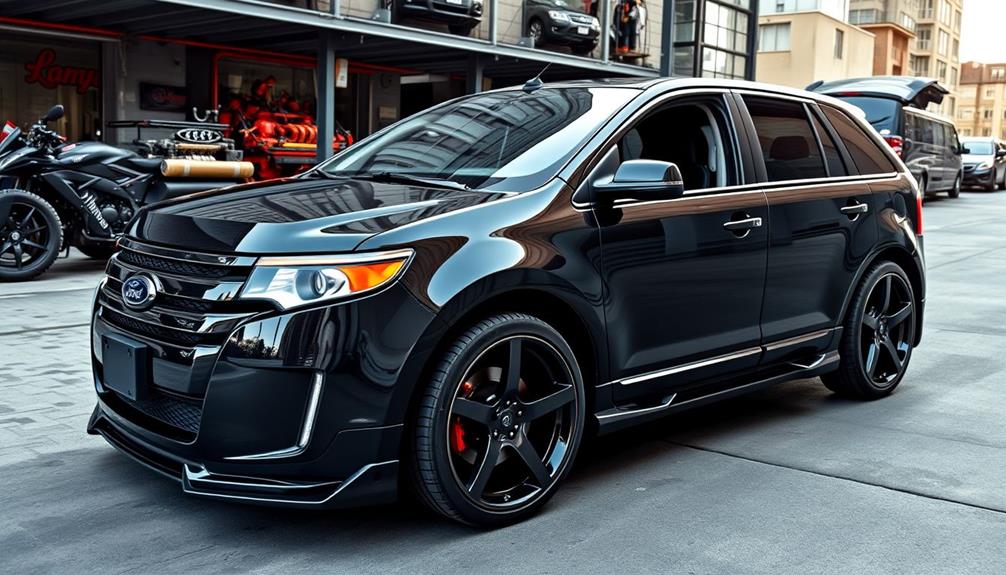
Tuning your 2011 Ford Edge can turn it into a performance beast. Start with simple modifications like a Cold Air Intake and a Magna Flow exhaust to enhance efficiency and power. You'll see modest horsepower gains, with peak outputs hitting around 221.7 HP at the wheels after dyno testing. Understanding drivetrain losses, especially in all-wheel-drive systems, is key to maximizing your upgrades. As you tweak your vehicle, real-world performance will improve over time. Plus, joining the Ford Edge community offers valuable insights and support. Keep exploring, and you'll uncover even more tuning tips and tricks!
Key Takeaways
- Upgrading to a Cold Air Intake (CAI) and Magna Flow exhaust can slightly boost horsepower and enhance engine efficiency in the Ford Edge 2011.
- Regular dyno testing helps establish performance benchmarks and track improvements post-tuning, revealing true horsepower gains after modifications.
- Understanding drivetrain losses is essential; AWD configurations can experience up to 28% reduction in power delivered to the wheels.
- Installing a Pedal Commander optimizes throttle response, allowing for a more engaging driving experience with various driving modes.
- Engaging with the Ford Edge community fosters knowledge sharing on effective tuning practices and real-world performance outcomes.
Understanding Performance Modifications
When tuning your 2011 Ford Edge Sport, it's crucial to understand how performance modifications can impact your vehicle's efficiency and power. Upgrades like a cold air intake (CAI) and a Magna Flow exhaust are popular choices among enthusiasts for enhancing engine performance.
While these modifications can improve sound and efficiency, don't expect dramatic horsepower increases. Often, you'll see only modest gains in power, with real-world results sometimes falling short of theoretical expectations.
For instance, after tuning, your Edge Sport might achieve a peak output of 221.7 HP at the wheels. It's important to remember that drivetrain losses, estimated at around 20%, can affect overall performance. This means your actual gains might be less than what the numbers suggest on paper.
As you dive deeper into Ford tuning, keep in mind that future modifications and additional mileage can lead to better results. Initial dyno figures mightn't tell the whole story; as your engine breaks in and you make further adjustments, performance can improve.
Evaluating Dyno Test Results
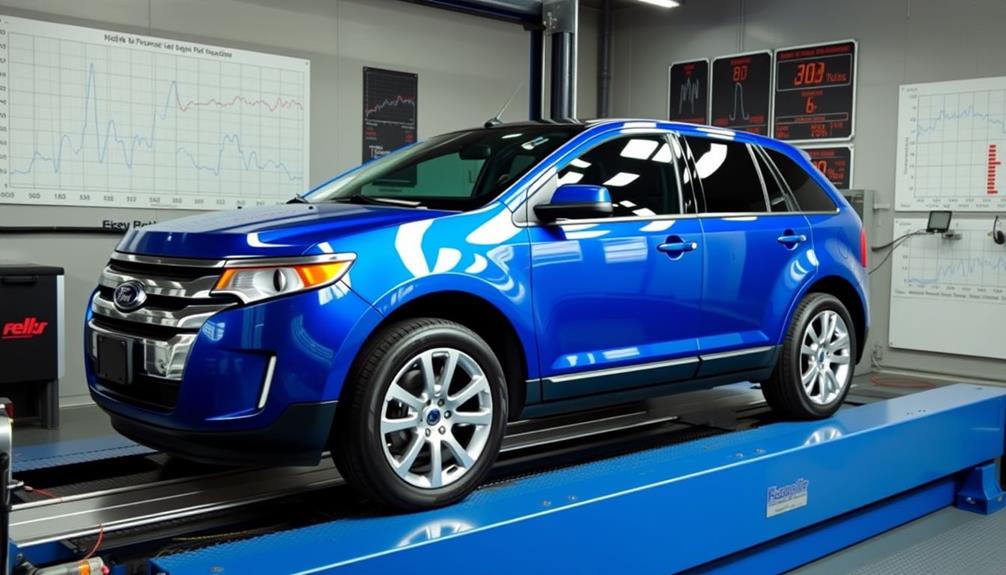
Evaluating dyno test results is essential for understanding the effectiveness of your tuning modifications on the 2011 Ford Edge Sport. After modifications, your vehicle showed a peak output of 221.7 HP at the wheels, reflecting considerable power gains over the stock performance.
Initially, during the cold run, it recorded only 185 HP, underscoring how critical it's to warm up your engine for accurate testing.
One important observation is the air to fuel ratio drop around 4200 RPMs during the initial run, which tuning corrected for smoother acceleration. These adjustments not only improve performance but also guarantee a more consistent driving experience.
Additionally, keep in mind that the estimated drivetrain loss was around 120 HP, leading to a 28% reduction from engine to wheels. This highlights how drivetrain efficiency can considerably affect your overall performance assessments.
Also, be aware that different dyno types yield varying results. For instance, Mustang dyno results typically show lower horsepower numbers than those from Dynojet, which could account for some discrepancies in reported power gains.
Types of Dyno Testing
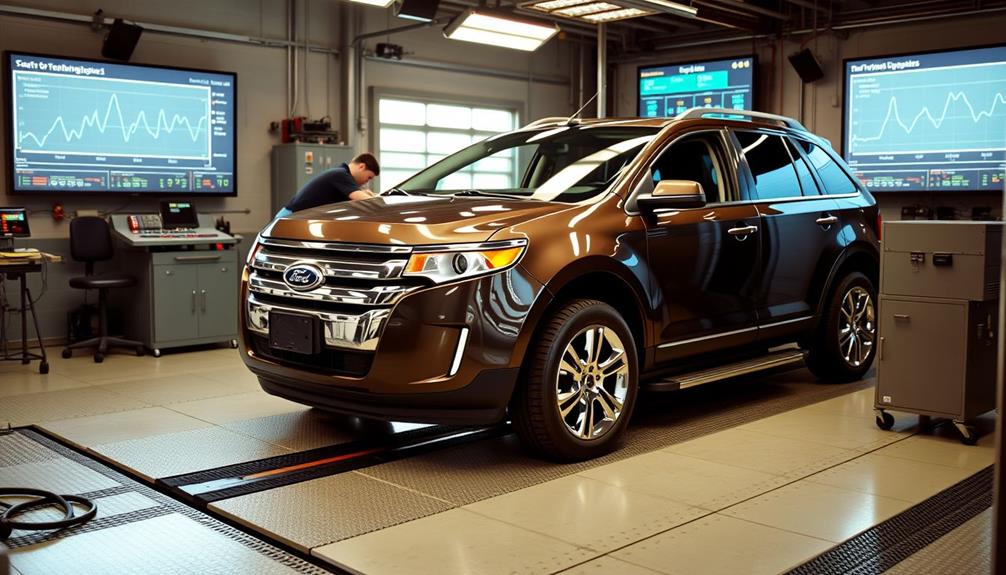
When tuning your Ford Edge, understanding the differences between dyno types is essential.
You'll encounter Mustang dynos, which simulate real road conditions, and Dynojet, which often shows higher peak numbers.
Additionally, factors like elevation can drastically affect your results, so it's important to take into account all these elements for accurate performance assessments.
Mustang Vs. Dynojet Differences
Understanding the differences between Mustang and Dynojet dynos is essential for anyone looking to tune their Ford Edge or any other performance vehicle.
Mustang dynos typically provide lower horsepower numbers because they feature a loaded system design that simulates real road conditions. This design accounts for drivetrain losses more accurately, giving you a realistic view of your vehicle's performance.
In contrast, Dynojet dynos operate unloaded, often yielding higher and more consistent horsepower readings.
For instance, a Roush vehicle recorded 345 rwhp on a Mustang dyno, but it achieved 380 hp on a Dynojet. This discrepancy highlights the variability between the two types of dynos. While Dynojet can showcase significant potential gains, it may overshoot what you can realistically expect on the road.
Environmental factors like elevation can further complicate comparisons, with a potential 20% power loss at high altitudes.
To get meaningful results, consider performing stock dyno tests on both dyno types before modifications. This will give you valuable baseline comparisons to gauge the effectiveness of your tuning and performance upgrades.
Loaded Vs. Unloaded Testing
Precision in performance testing hinges on the choice between loaded and unloaded dyno methods. When tuning your Ford Edge, understanding these differences is critical.
Loaded dynos, such as Mustang dynos, simulate real-world driving conditions by applying resistance during testing. This creates a more accurate representation of horsepower, allowing you to gauge your vehicle's true performance potential under load. While loaded dynos typically yield lower horsepower figures, they provide insights that are more reflective of on-road driving.
In contrast, unloaded dynos, like Dynojet, operate without resistance, often resulting in higher horsepower numbers. Although these results are consistent, they may not accurately depict how your vehicle will perform in real-world scenarios. Consequently, while unloaded dynos can be useful for specific applications, they might mislead you when evaluating modifications on your Ford Edge Sport.
Ultimately, the choice between loaded and unloaded testing can greatly impact your tuning outcomes. If you're after genuine performance gains, loaded dynos are the way to go, ensuring your modifications translate well to actual driving conditions.
Understanding these testing methods will help you make informed decisions, enhancing your crossover's performance capabilities.
Impact of Elevation Factors
Elevation factors play an important role in tuning your Ford Edge, especially when it comes to dyno testing. As you venture into high altitudes, the decreased air density can lead to a significant 20% loss in horsepower for naturally aspirated engines. This makes it vital to take elevation into account when evaluating your vehicle's performance.
When testing your Ford Edge on a dyno, here are four key points to keep in mind regarding elevation:
- Dyno Type Matters: Mustang dynos simulate real-world load conditions but may show lower horsepower numbers compared to Dynojet dynos, which operate unloaded.
- Baseline Testing: Conduct stock dyno tests before modifications to establish a reliable baseline. This helps you gauge the effectiveness of any performance upgrades you make later.
- Calibration Variability: Different dyno setups can lead to variability in horsepower readings, so multiple tests are often necessary for accurate comparisons.
- Real-World Relevance: Loaded dynos like the Mustang are better for evaluating performance as they replicate actual driving conditions more closely than unloaded systems.
Understanding these factors will aid you in optimizing your Ford Edge for any elevation.
Community Feedback and Insights

The Ford Edge community has been instrumental in shaping tuning practices and sharing valuable insights. Through community feedback, members have discovered that simple modifications like a cold air intake and exhaust may yield only slight horsepower increases initially.
However, many have reported noticeable real-world performance improvements as mileage and tuning adjustments progressed. Discussions often emphasize the importance of distinguishing between engine horsepower and wheel horsepower. Users recommend conducting further dyno tests to accurately assess performance gains post-tuning.
For instance, initial dyno results for the modified Ford Edge Sport showed a peak output of only 221.7 HP at the wheels, which was considerably lower than many expected. Additionally, community members have shared their experiences of test driving other Edge Sports to compare performance, highlighting the variability in tuning outcomes.
This reinforces the need for ongoing collaboration on performance tests. By sharing dyno results and insights, you can gain a better understanding of tuning effectiveness for your Ford Edge. The collective knowledge and support within the community are invaluable for optimizing modifications and enhancing your driving experience.
Powertrain Dynamics Explained
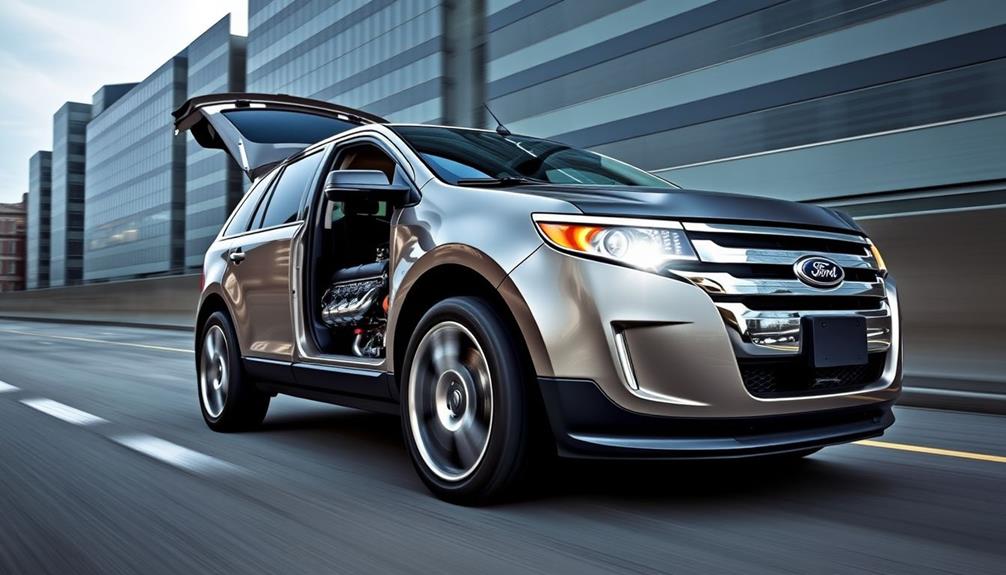
When tuning your 2011 Ford Edge, understanding drivetrain losses is essential, as they can greatly affect your car's performance.
If you opt for all-wheel drive, you'll notice about a 10% power loss compared to front-wheel drive, which impacts how power reaches the wheels.
Drivetrain Losses Explained
Drivetrain losses, often overlooked yet critical, refer to the power reduction that occurs as engine output travels to the wheels. For most vehicles, including your 2011 Ford Edge Sport, you can expect to lose around 20% of the engine's horsepower before it reaches the wheels. This means that if your engine produces 300 HP, only about 240 HP is available for driving.
Understanding drivetrain losses is essential when tuning your vehicle. Here are a few key points to evaluate:
- Power Loss: With an estimated 120 HP lost in the Ford Edge Sport, tuning efforts must account for this reduction.
- AWD vs. FWD: All-Wheel Drive vehicles typically experience about 10% more drivetrain losses due to extra components.
- Elevation Effects: High altitudes can further decrease performance, especially in naturally aspirated engines, which may see a 20% drop.
- Performance Modifications: Always factor in drivetrain losses to accurately gauge the impact of any performance upgrades you make.
AWD Vs. FWD Performance
Understanding the differences in performance between All-Wheel Drive (AWD) and Front-Wheel Drive (FWD) is key for anyone tuning a 2011 Ford Edge. AWD systems generally lose about 10% of power due to the extra components needed to send power to all four wheels. This results in a significant reduction of around 28% from engine output to wheels, especially evident in dyno results after tuning.
While AWD improves traction and stability in poor weather, it doesn't always translate to better horsepower at the wheels compared to FWD.
On the flip side, FWD configurations often allow you to harness more raw power, making them quicker in straight-line performance. However, AWD vehicles can provide a more balanced driving experience, enhancing handling and cornering capabilities.
If you modify your Edge's AWD system correctly, you can achieve impressive figures around 270-280 all-wheel horsepower (AWHP) or more.
Upcoming Dyno Testing Plans
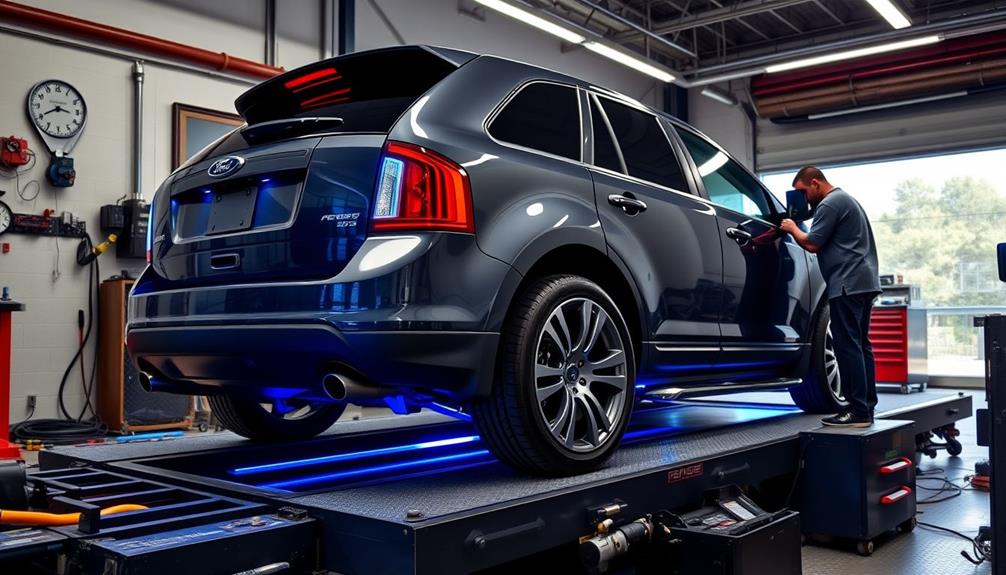
Exciting plans are underway for dyno testing on a stock 2011 Ford Edge Sport to establish baseline performance metrics.
You'll witness firsthand how your vehicle's performance can transform with the right modifications. The initial run will give you a solid benchmark before diving into enhancements like a Prozenmotorsports Cold Air Intake and a Magna Flow exhaust.
Here's what to expect from the upcoming dyno testing:
- Baseline Metrics: The first dyno run will measure your Edge's current horsepower and torque, helping you understand its starting point.
- Tuned Run: After modifications, a second run will assess the performance impacts, potentially reaching 270-280 AWHP or more.
- Dyno Comparisons: You'll learn about the differences between Mustang and Dynojet setups, emphasizing the importance of choosing the right dyno for accurate assessments.
- Community Sharing: Engage with fellow enthusiasts as you share your results, fostering discussions on performance gains achieved through tuning and modifications.
Enhancing Vehicle Technology

Enhancing vehicle technology in your 2011 Ford Edge Sport can greatly elevate your driving experience. One effective aftermarket upgrade is the Pedal Commander, which optimizes throttle response and improves overall performance without requiring extensive modifications.
This device features four driving modes—ECO, Sport, City, and Sports Plus—allowing you to tailor your driving dynamics based on your needs and conditions.
With its simple plug-and-play installation, you can skip the mechanic fees and enjoy immediate performance boosts. The Pedal Commander not only enhances acceleration but also contributes to overall vehicle efficiency, helping you achieve better fuel economy and reduced emissions.
Investing in such affordable aftermarket technologies is a smart choice for Ford owners looking to maximize control over their vehicles.
By integrating these advanced upgrades, you'll experience a driving transformation that makes your 2011 Ford Edge Sport feel more responsive and engaging.
Whether you're maneuvering through city streets or hitting the highway, these enhancements guarantee you're always in command, making your everyday drives much more enjoyable.
Industry Trends and Challenges

The automotive industry is currently maneuvering a complex landscape filled with significant challenges and evolving trends. As a Ford owner or enthusiast, you should pay attention to how these factors might influence your vehicle's performance and reliability.
1. Quality Assurance: Major brands, including Ford, face recall challenges that spotlight systemic manufacturing issues. This can affect the availability of performance parts.
The emphasis on quality assurance in software development reflects a broader trend of ensuring high standards across industries, including automotive.
2. Aging Workforce: An aging workforce in manufacturing has created skill gaps, impacting production efficiency and quality.
3. Long-term Investments: Companies are shifting focus, prioritizing long-term quality improvements over quick cost savings. This means better durability and performance for your vehicle.
4. Fuel Economy Innovations: With competition heating up, automakers are investing in technologies that enhance fuel economy, making vehicles more appealing to consumers.
Balancing innovation with user-friendly designs is vital. Excessive in-car technology can detract from the driving experience, a factor many consumers aren't thrilled about.
You can expect Ford and other manufacturers to adapt to these trends, aiming for better quality assurance and competitive performance that aligns with customer expectations. Staying informed will help you make smart choices for tuning your Ford Edge 2011 and transforming it into a true performance beast.
Frequently Asked Questions
How Much Horsepower Does a 2011 Ford Edge Limited Have?
The 2011 Ford Edge Limited has a factory-rated horsepower of 285 HP at the crank. After drivetrain losses, you'll typically see around 230-240 HP at the wheels, depending on various performance factors.
What Does Crossover Mean in Ford Edge?
A crossover blends the best of both worlds—car-like comfort and SUV versatility. In your Ford Edge, this means a spacious interior, higher driving position, and improved fuel efficiency, making it ideal for families and commuters alike.
Do Ford Edges Have Sport Mode?
Yes, Ford Edges do have a sport mode. When you engage it, you'll notice quicker acceleration and enhanced handling. It transforms your driving experience, making it more dynamic and enjoyable for spirited situations.
What Chassis Is the Ford Edge Built On?
The Ford Edge is built on the CD3 platform, which supports a weight-saving design. Its high-strength steel chassis enhances safety and structural integrity, giving you a reliable and spacious crossover for everyday driving adventures.
Conclusion
In transforming your 2011 Ford Edge into a performance beast, you're not just making modifications—you're crafting a driving experience that echoes with power and precision. As you embrace the latest tuning trends and community insights, remember: every tweak you make is a step toward revealing your vehicle's true potential. So, why settle for ordinary when extraordinary lies just a few enhancements away? Immerse yourself in the world of performance tuning and let your Edge roar like never before!
Alex is our go-to expert on performance tuning, with over a decade of experience in the automotive industry. His deep understanding of engine dynamics, exhaust systems, and performance software allows him to break down complex concepts into easy-to-follow guides. Whether you’re looking to boost horsepower or fine-tune your vehicle’s responsiveness, Alex’s insights will help you achieve peak performance.
-

 Hybrid Tuning3 months ago
Hybrid Tuning3 months agoHonda Civic Hybrid Tuning: Unlocking Maximum Efficiency and Performance
-

 Hybrid Tuning3 months ago
Hybrid Tuning3 months agoPorsche Cayenne E-Hybrid Tuning: Unleashing the Beast Within the Luxury SUV
-

 Audi Tuning3 months ago
Audi Tuning3 months agoChip Tuning Audi: How to Unlock Extra Power Instantly
-

 Automotive DIY and Professional Guides3 months ago
Automotive DIY and Professional Guides3 months agoWhen Is Car Tuning Required? Signs It’s Time for an Upgrade
-

 Audi Tuning3 months ago
Audi Tuning3 months agoAudi A3 Tuning: Elevate Your Compact Car’s Performance
-

 Hybrid Tuning3 months ago
Hybrid Tuning3 months agoInfiniti Q50 Hybrid Chip Tuning: Enhance Performance With Precision Tuning
-

 Hybrid Tuning3 months ago
Hybrid Tuning3 months agoNissan Altima Hybrid Tuning: Upgrade Your Sedan for Maximum Efficiency
-

 Hybrid Tuning3 months ago
Hybrid Tuning3 months agoCube Reaction Hybrid Tuning: Get the Most Out of Your Electric Bike





